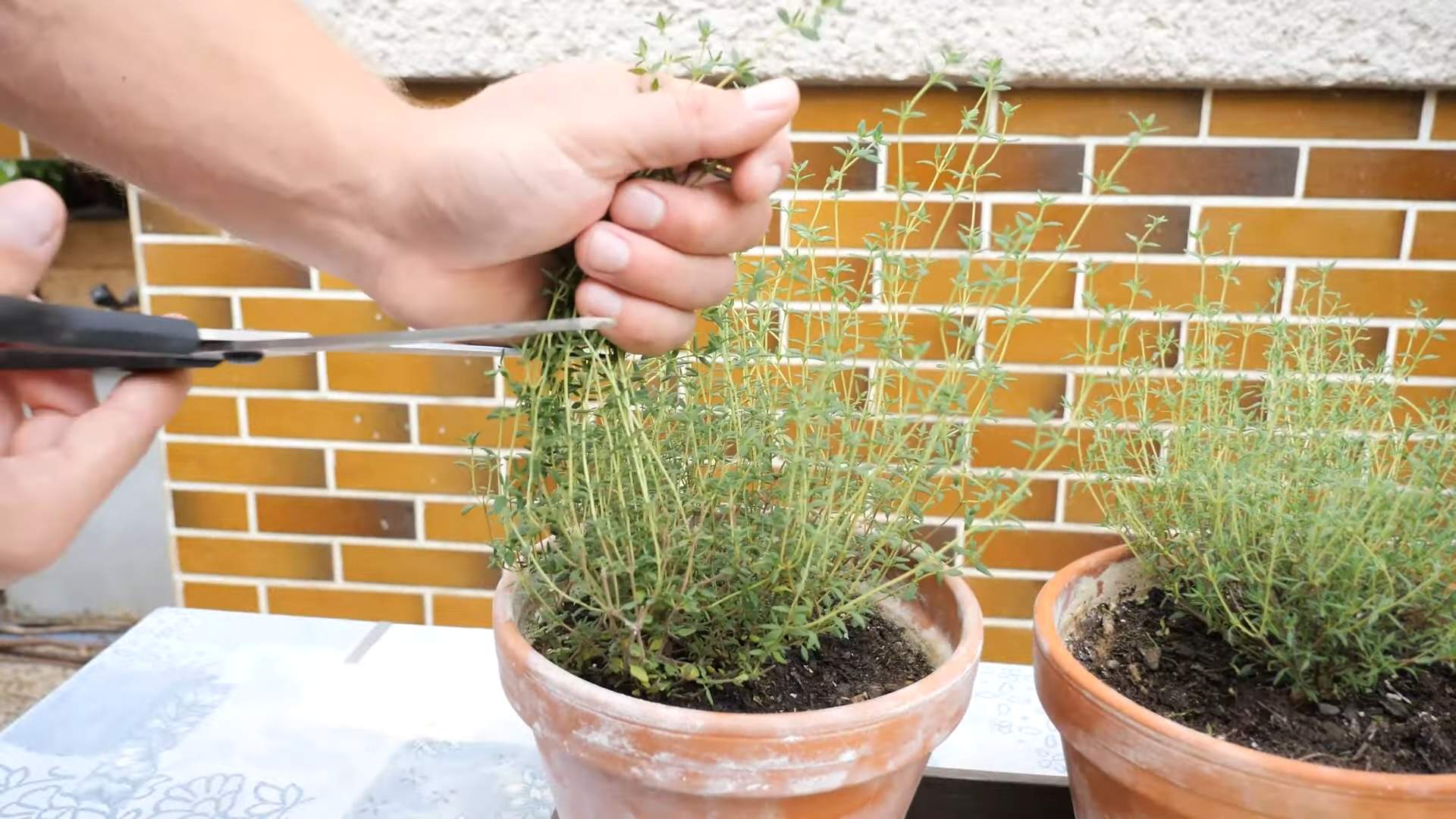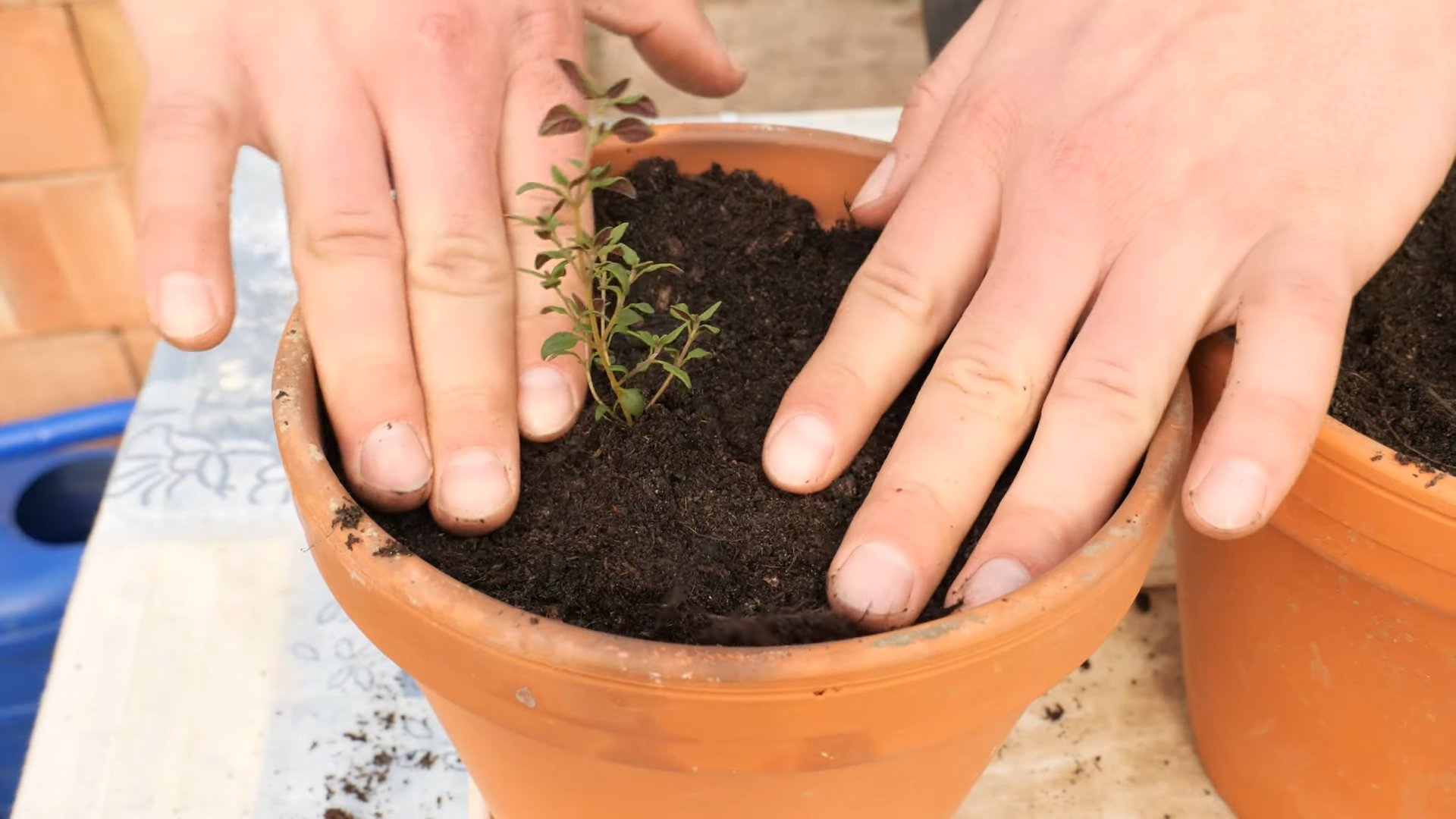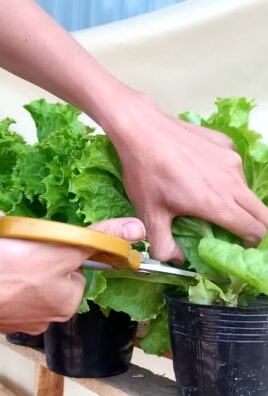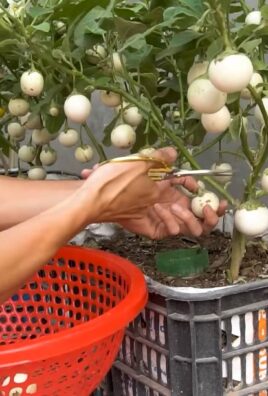Grow Thyme Indoors: Imagine stepping into your kitchen and snipping fresh, fragrant thyme to elevate your culinary creations. No more last-minute dashes to the grocery store or settling for dried herbs! This isn’t just a dream; it’s an achievable reality with a few simple DIY tricks. For centuries, thyme has been cherished not only for its culinary uses but also for its medicinal properties and symbolic meaning, representing courage and bravery in ancient cultures.
But let’s be honest, who has the time and space for a sprawling outdoor herb garden? That’s where the magic of indoor gardening comes in! I’m here to show you how easy and rewarding it can be to grow thyme indoors, even if you have limited space or a less-than-green thumb. This DIY guide is packed with practical tips and hacks to ensure your thyme thrives, bringing a touch of freshness and flavor to your home all year round.
Why do you need this DIY trick? Because fresh thyme elevates everything from roasted vegetables to hearty stews. Plus, nurturing a living plant indoors is incredibly therapeutic. So, let’s ditch the store-bought stuff and embark on this exciting journey of growing your own thyme indoors!

Growing Thyme Indoors: A Beginner’s Guide to a Thriving Herb Garden
Hey there, fellow plant enthusiasts! I’m so excited to share my experience with growing thyme indoors. It’s easier than you might think, and having fresh thyme readily available for cooking is a total game-changer. Plus, the aroma is just divine! Let’s dive into how you can create your own little thyme haven indoors.
What You’ll Need
Before we get started, let’s gather all the necessary supplies. This will make the whole process smoother and more enjoyable.
* **Thyme Seeds or a Thyme Plant:** You can start from seeds, which is more budget-friendly, or buy a small established plant for quicker results. I’ve done both, and honestly, both work great!
* **Small Pots with Drainage Holes:** Drainage is crucial! Thyme hates soggy roots. Choose pots that are at least 4-6 inches in diameter. Terracotta pots are my personal favorite because they allow the soil to breathe.
* **Well-Draining Potting Mix:** Regular garden soil is too heavy for indoor containers. Opt for a potting mix specifically formulated for herbs or vegetables. A mix containing perlite or vermiculite is ideal for good drainage.
* **Grow Lights (Optional but Recommended):** While thyme loves sunlight, it can be tricky to provide enough indoors, especially during winter. Grow lights can supplement natural light and ensure healthy growth.
* **Watering Can or Spray Bottle:** A watering can with a long spout is perfect for reaching the soil without splashing the leaves. A spray bottle is handy for misting seedlings.
* **Small Shovel or Trowel:** For transferring seedlings or plants into pots.
* **Plant Labels (Optional):** If you’re growing multiple herbs, labels will help you keep track of what’s what.
* **Scissors or Pruning Shears:** For harvesting and trimming your thyme.
Starting from Seeds: A Patient Approach
Growing thyme from seeds requires a bit more patience, but it’s incredibly rewarding to watch those tiny sprouts emerge.
1. **Sowing the Seeds:** Fill your pots with well-draining potting mix, leaving about an inch of space at the top. Moisten the soil gently with a spray bottle. Sprinkle the thyme seeds evenly over the surface of the soil. Thyme seeds are tiny, so don’t overcrowd them. Lightly press the seeds into the soil – they need light to germinate.
2. **Creating a Humid Environment:** Cover the pots with plastic wrap or a clear plastic bag to create a humid environment. This helps the seeds germinate. Place the pots in a warm location, ideally around 70-75°F (21-24°C).
3. **Germination Time:** Be patient! Thyme seeds can take anywhere from 14 to 21 days to germinate. Keep the soil consistently moist, but not soggy. Remove the plastic wrap or bag for a few hours each day to allow for air circulation and prevent mold growth.
4. **Thinning the Seedlings:** Once the seedlings have emerged and have a few sets of true leaves (the leaves that look like miniature versions of adult thyme leaves), thin them out. This means removing some of the seedlings to give the remaining ones enough space to grow. Choose the strongest-looking seedlings and gently snip off the weaker ones at the soil line with scissors. Aim for about 2-3 inches between seedlings.
5. **Providing Light:** Once the seedlings have emerged, they need plenty of light. Place them in a sunny windowsill that receives at least 6 hours of direct sunlight per day. If you don’t have enough natural light, supplement with grow lights.
6. **Watering Seedlings:** Water the seedlings regularly, but be careful not to overwater. The soil should be moist, but not soggy. Allow the top inch of soil to dry out between waterings.
Transplanting a Thyme Plant: A Quick Start
If you’re short on time or just want a head start, buying a small thyme plant is a great option.
1. **Choosing the Right Plant:** When selecting a thyme plant, look for one that is healthy and vibrant green. Avoid plants that are yellowing, wilting, or have signs of pests or diseases.
2. **Preparing the Pot:** Fill your pot with well-draining potting mix, leaving about an inch of space at the top.
3. **Removing the Plant from its Container:** Gently remove the thyme plant from its original container. If the roots are tightly bound, gently loosen them with your fingers.
4. **Planting the Thyme:** Place the thyme plant in the center of the pot and fill in around it with potting mix. Gently press down on the soil to secure the plant.
5. **Watering After Transplanting:** Water the thyme plant thoroughly after transplanting. This will help settle the soil and encourage root growth.
6. **Finding the Perfect Spot:** Place the thyme plant in a sunny windowsill that receives at least 6 hours of direct sunlight per day. If you don’t have enough natural light, supplement with grow lights.
Caring for Your Indoor Thyme
Now that your thyme is planted, it’s time to learn how to care for it so it thrives indoors.
1. **Light:** Thyme needs plenty of light to grow well. Aim for at least 6 hours of direct sunlight per day. If you don’t have enough natural light, supplement with grow lights. I use LED grow lights, and they work wonders!
2. **Watering:** Water your thyme regularly, but be careful not to overwater. Overwatering is a common mistake that can lead to root rot. Allow the top inch of soil to dry out between waterings. When you do water, water thoroughly until water drains out of the drainage holes.
3. **Fertilizing:** Thyme doesn’t need a lot of fertilizer, but a light feeding every few weeks can help it grow. Use a balanced liquid fertilizer diluted to half strength. I prefer organic fertilizers, but any balanced fertilizer will do.
4. **Pruning:** Pruning is essential for keeping your thyme plant healthy and productive. Regular pruning encourages bushier growth and prevents the plant from becoming leggy. Pinch off the tips of the stems regularly to encourage branching.
5. **Harvesting:** You can start harvesting thyme once the plant is established and has grown several inches tall. Simply snip off the stems with scissors or pruning shears. Harvest regularly to encourage new growth. I love adding fresh thyme to soups, stews, roasted vegetables, and even cocktails!
6. **Pest Control:** Keep an eye out for pests such as aphids, spider mites, and whiteflies. If you notice any pests, treat them promptly with insecticidal soap or neem oil. I prefer to use organic pest control methods whenever possible.
7. **Repotting:** As your thyme plant grows, it may need to be repotted into a larger container. Repotting is usually necessary every 1-2 years. Choose a pot that is 1-2 inches larger in diameter than the current pot.
Troubleshooting Common Problems
Even with the best care, you might encounter some problems while growing thyme indoors. Here are some common issues and how to fix them:
* **Yellowing Leaves:** Yellowing leaves can be a sign of overwatering, underwatering, or nutrient deficiency. Check the soil moisture and adjust your watering accordingly. If the soil is consistently moist, you’re probably overwatering. If the soil is dry, you’re probably underwatering. If the problem persists, try fertilizing your thyme with a balanced liquid fertilizer.
* **Leggy Growth:** Leggy growth is when the stems become long and spindly with few leaves. This is usually caused by insufficient light. Move your thyme plant to a sunnier location or supplement with grow lights. Pruning can also help encourage bushier growth.
* **Root Rot:** Root rot is a fungal disease that can occur when the soil is consistently soggy. The roots will turn brown and mushy, and the plant will eventually die. To prevent root rot, make sure your thyme is planted in well-draining soil and avoid overwatering. If you suspect root rot, repot your thyme in fresh soil and trim away any affected roots.
* **Pests:** Pests such as aphids, spider mites, and whiteflies can infest thyme plants. Treat them promptly with insecticidal soap or neem oil.
Enjoying Your Homegrown Thyme
The best part about growing thyme indoors is being able to enjoy fresh, flavorful herbs whenever you want! Here are some of my favorite ways to use homegrown thyme:
* **Cooking:** Thyme is a versatile herb that can be used in a variety of dishes. I love adding it to soups, stews, roasted vegetables, meats, and poultry.
* **Teas:** Fresh thyme can be used to make a soothing and flavorful tea. Simply steep a few sprigs of thyme in hot water for 5-10 minutes.
* **Aromatherapy:** The aroma of thyme is known to be calming and uplifting. Place a few sprigs of thyme in a diffuser or simply rub the leaves between your fingers to release the scent.
* **Garnish

Conclusion
So, there you have it! Growing thyme indoors is not only achievable, but it’s also a rewarding experience that brings the fresh, aromatic flavors of the Mediterranean right into your kitchen. Forget those sad, dried-out jars of thyme from the supermarket; with a little effort, you can have a constant supply of vibrant, flavorful thyme at your fingertips.
Why is this DIY trick a must-try? Because it empowers you to control the quality and freshness of your herbs. You know exactly where your thyme is coming from, what it’s been exposed to, and how it’s been cared for. Plus, it’s incredibly satisfying to nurture a plant from a tiny seedling or cutting into a thriving herb that enhances your culinary creations. Imagine the burst of flavor you’ll get when you add freshly snipped thyme to your roasted chicken, your favorite pasta sauce, or even a simple cup of herbal tea.
But the benefits don’t stop there. Growing thyme indoors also adds a touch of greenery to your home, creating a more inviting and vibrant atmosphere. It’s a small but significant way to connect with nature, even when you’re stuck indoors. And let’s not forget the cost savings! Over time, growing your own thyme will undoubtedly save you money compared to constantly buying it from the store.
Looking for variations? Consider experimenting with different varieties of thyme. Lemon thyme adds a bright, citrusy note to dishes, while creeping thyme is perfect for ground cover if you decide to transplant some of your indoor thyme outdoors in the spring. You can also try growing thyme from seeds or cuttings, each offering a unique learning experience. Another fun variation is to create a small herb garden featuring thyme alongside other complementary herbs like rosemary, oregano, and sage. This allows you to have a diverse range of fresh herbs readily available for all your cooking needs.
Don’t be intimidated if you’ve never grown herbs indoors before. Thyme is a relatively low-maintenance plant, making it a great choice for beginners. Just remember the key elements: plenty of sunlight, well-draining soil, and careful watering. With a little patience and attention, you’ll be harvesting your own fresh thyme in no time.
We wholeheartedly encourage you to give this DIY trick a try. It’s a simple, affordable, and incredibly rewarding way to elevate your cooking and bring a touch of nature into your home. Once you experience the joy of growing your own thyme, you’ll never go back to store-bought again.
So, grab a pot, some soil, and a thyme plant (or seeds!), and get started today. We’re confident that you’ll be thrilled with the results. And most importantly, we want to hear about your experience! Share your tips, successes, and even your challenges in the comments below. Let’s create a community of indoor thyme growers and learn from each other. Happy growing! Let us know how your indoor thyme garden is flourishing!
FAQ
What kind of soil is best for growing thyme indoors?
Well-draining soil is crucial for growing thyme indoors. Thyme is susceptible to root rot if the soil stays too wet. A good mix is a combination of potting soil, perlite, and sand. This combination ensures that the soil retains enough moisture to nourish the plant but also allows excess water to drain away quickly. Avoid using heavy garden soil, as it tends to compact and retain too much water. You can also find specialized herb potting mixes at most garden centers, which are formulated to provide the ideal growing conditions for herbs like thyme.
How much sunlight does indoor thyme need?
Thyme thrives in bright sunlight, so aim for at least six hours of direct sunlight per day. A south-facing window is usually the best option, but an east- or west-facing window can also work if it provides sufficient light. If you don’t have access to enough natural light, you can supplement with a grow light. Position the grow light a few inches above the plant and keep it on for 12-14 hours per day. Insufficient sunlight can lead to leggy growth and a lack of flavor in the thyme.
How often should I water my indoor thyme plant?
Water your thyme plant when the top inch of soil feels dry to the touch. Avoid overwatering, as this can lead to root rot. When you do water, water thoroughly until the water drains out of the bottom of the pot. Then, allow the soil to dry out again before watering again. During the winter months, when the plant is not actively growing, you may need to water less frequently. Always check the soil moisture before watering to avoid overwatering.
How do I harvest thyme from my indoor plant?
Harvest thyme by snipping off stems with clean scissors or pruning shears. Avoid cutting more than one-third of the plant at a time, as this can stress the plant. The best time to harvest thyme is in the morning, after the dew has dried but before the sun gets too hot. This is when the plant’s essential oils are most concentrated, resulting in the most flavorful thyme. You can use the fresh thyme immediately or dry it for later use.
How do I dry thyme from my indoor plant?
There are several ways to dry thyme. One method is to tie the stems together in small bundles and hang them upside down in a cool, dry, and well-ventilated place. Another method is to spread the stems out on a baking sheet and dry them in a low oven (around 170°F) for a few hours. You can also use a dehydrator to dry thyme. Once the thyme is completely dry, crumble the leaves and store them in an airtight container in a cool, dark place.
My thyme plant is looking leggy and weak. What should I do?
Leggy growth in thyme is often a sign of insufficient sunlight. Move your plant to a sunnier location or supplement with a grow light. You can also prune the leggy stems to encourage bushier growth. Make sure you are not overwatering the plant, as this can also contribute to weak growth. Check the soil drainage and adjust your watering schedule as needed. Fertilizing with a balanced liquid fertilizer can also help to promote healthy growth.
Can I grow thyme from cuttings?
Yes, growing thyme from cuttings is a relatively easy way to propagate new plants. Take a 4-6 inch cutting from a healthy thyme plant, removing the leaves from the bottom inch of the stem. Dip the cut end in rooting hormone (optional) and plant it in a small pot filled with well-draining potting mix. Water the cutting and cover it with a plastic bag or humidity dome to create a humid environment. Place the cutting in a bright, indirect light location and keep the soil moist but not soggy. After a few weeks, the cutting should develop roots and begin to grow.
What are some common pests and diseases that affect indoor thyme?
Thyme is generally resistant to pests and diseases, but it can be susceptible to aphids, spider mites, and root rot. Check your plant regularly for signs of pests, such as small insects or webbing on the leaves. If you find pests, you can try washing them off with a strong stream of water or using an insecticidal soap. To prevent root rot, avoid overwatering and ensure that the soil is well-draining. Good air circulation can also help to prevent fungal diseases.
How often should I fertilize my indoor thyme plant?
Thyme doesn’t require heavy fertilization. Fertilize your plant every 2-3 months with a balanced liquid fertilizer diluted to half strength. Avoid over-fertilizing, as this can lead to leggy growth and a decrease in flavor. During the winter months, when the plant is not actively growing, you can reduce or eliminate fertilization.
Can I move my indoor thyme plant outdoors in the summer?
Yes, you can move your indoor thyme plant outdoors in the summer, but it’s important to acclimate it gradually to the outdoor conditions. Start by placing the plant in a shady location for a few hours each day, gradually increasing the amount of sunlight it receives over a week or two. Make sure the plant is protected from strong winds and heavy rain. Bring the plant back indoors before the first frost in the fall.




Leave a Comment